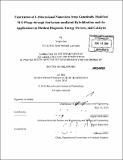Fabrication of 1-dimensional nanowires from genetically modified M13 phage through surfactant-mediated hybridization and the applications in medical diagnosis, energy devices, and catalysis
Author(s)
Lee, Youjin
DownloadFull printable version (21.25Mb)
Other Contributors
Massachusetts Institute of Technology. Dept. of Materials Science and Engineering.
Advisor
Angela M. Belcher.
Terms of use
Metadata
Show full item recordAbstract
Biological building blocks served as excellent templates for the preparation of various nano-materials due to their beneficial interactions at the molecular level. The bio-mineralization of genetically engineered M13 bacteriophage resulted in one-dimensional nanowires having outstanding properties in diverse applications. As a bridge between the chemical synthesis of nanostructures and the bio-mineralization of M13 phage, surfactant molecules were introduced to the biological systems. The specific affinity of M13 phage with Au-binding peptides was strong enough to attract Au ions despite the existence of surfactant molecules. Consequently, the surfactant-mediated bio-mineralization of M13 phage enabled us to precisely control the morphologies and structures in nanometer scale. The Au-binding M13 phage could also integrate other noble metals (Ag/Pt/Pd) to prepare homogeneous Au-based noble metal alloy nanowires in structures and compositions, and their electrochemical properties upon the systematic changes in compositions were investigated. Especially for the Au-Pt system, the catalytic activity study on the two distinct structures, the alloy and the core/shell, provided us important factors to design new catalysts with optimized activities.
Description
Thesis (Ph. D.)--Massachusetts Institute of Technology, Dept. of Materials Science and Engineering, 2010. Vita. Includes bibliographical references.
Date issued
2010Department
Massachusetts Institute of Technology. Department of Materials Science and EngineeringPublisher
Massachusetts Institute of Technology
Keywords
Materials Science and Engineering.